Ducal Castle, Szczecin
The Ducal Castle in Szczecin, Poland, (Polish: Zamek Książąt Pomorskich w Szczecinie) was the seat of the dukes of Pomerania-Stettin of the House of Pomerania (Griffins), who ruled the Duchy of Pomerania from 1121 to 1637.
| Ducal Castle | |
|---|---|
 General view of the castle. | |
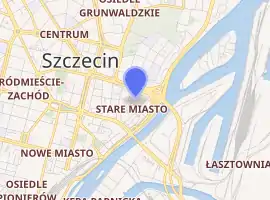
| |
| General information | |
| Architectural style | Gothic, Pomeranian mannerism |
| Town or city | Szczecin |
| Country | Poland |
| Construction started | 1346 |
| Completed | 1428 |
| Demolished | 1944 |
| Design and construction | |
| Architect | Wilhelm Zachariasz Italus (mannerist reconstruction) |
History
Barnim the Great of Pomerania-Stettin erected the castle within Szczecin's walls against the will of the burghers in 1346. An older Pomeranian burgh had been leveled in 1249.[1] In 1490 the castle was partially reconstructed for Bogusław X's wedding with Anna Jagiellonka (daughter of king Casimir IV Jagiellon).[2]
Between 1573 and 1582 the castle was rebuilt again, this time in the mannerist style for duke John Frederick by Italian stonemasons according to design by Wilhelm Zachariasz Italus.[3][4] Two new wings were added to close the courtyard before the medieval southern and eastern wings.[3] The main gate was adorned with ducal crest, the eastern wing was enhanced and the northern wing was intended for chapel.
In 1648, due to the tenets of the Peace of Westphalia, the castle become a seat of Swedish governor.[5] Before 1705 another reconstruction occurred to prepare the castle for Queen of Poland - Catherine Opalińska, who lived here with her daughters Anna and Marie Leszczyńska (future Queen of France) and a small court between 1705 and 1711.[5] In 1711 king Stanisław I Leszczyński, who sought refuge before chasing him Saxon and Russian forces, joined his wife and daughters at the castle.[5]
After the Great Northern War, in 1720, the city of Stettin become a Prussian property and the castle was allocated to the garrison commander Christian August, Prince of Anhalt-Zerbst, whose daughter Sophie Friederike Auguste (future Catherine II of Russia) was born here in 1729 and was raised in the castle.[5]
Under Swedish and later Prussian rule, the castle was extensively modified. In 1840-42 a tower in Classical architecture in allusion to the architecture of Karl Friedrich Schinkel was erected, and the south wing was built in the style of Frederician Rococo.[6]
Polish conservations maintain that these modifications under Prussian rule in the 19th were barbaric,[6] devastating the many Renaissance elements in the castle (arcades, attics, vaulting).[2] Eventually about 60% of the castle was destroyed during World War II (August 1944).[5]
Under Polish rule, the castle was rebuilt between 1958 and 1980 with some modifications. The castle was seen as a point of contact with the town's lost Slavic past, supporting and legitimizing the cleansing of Germans and subsequent Polonization.[6] The castle was restored to its original 16th-century appearance according to 1653 engraving by Matthäus Merian (among others).[2] The refernence to the Renaissane appearance was important because during Renaissance times, the town, part of the Holy Roman Empire was ruled by the House of Griffin, whose Slavic or even Piast descence is debated among historians. The castle thus became a lieu de mémoire for the town's new inhabitants.
Gallery
.jpg.webp) View from one of the towers
View from one of the towers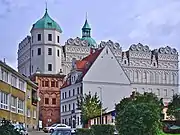 The Ducal Castle in Szczecin
The Ducal Castle in Szczecin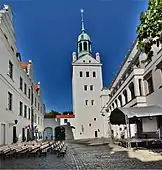 The tower seen from the courtyard
The tower seen from the courtyard Side view with one of the towers
Side view with one of the towers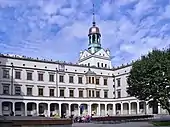 Inner courtyard
Inner courtyard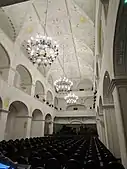 Former castle chapel
Former castle chapel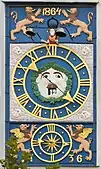 Clock on the castle's clock tower
Clock on the castle's clock tower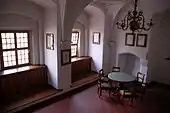 One of the chambers
One of the chambers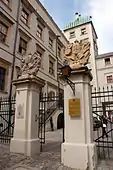 Gate
Gate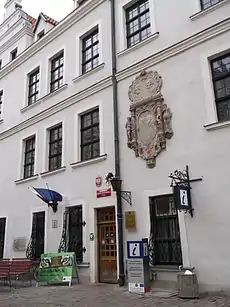 Culture and Tourism Center
Culture and Tourism Center
Footnotes
- Werner Buchholz, Pommern, Siedler, 1999, p.121, ISBN 3-88680-272-8
- "History". zamek.szczecin.pl. Retrieved 2009-12-28.
- "Historia". zamek.szczecin.pl (in Polish). Archived from the original on 2010-01-20. Retrieved 2009-12-28.
- Kazimiera Kalita Skwirzyńska, Ewa Prync-Pommerencke. "Zamki i dwory renesansowe". www.pomorskiezamki.pl (in Polish). Archived from the original on 2007-08-29. Retrieved 2009-12-28.
- "Szczecin". www.zamkipolskie.com (in Polish). Retrieved 2009-12-28.
- Peter Oliver Loew, Christian Pletzing, Thomas Serrier (2006). Wiedergewonnene Geschichte: zur Aneignung von Vergangenheit in den Zwischenräumen Mitteleuropas (in German). Otto Harrassowitz Verlag.CS1 maint: multiple names: authors list (link)
External links
| Wikimedia Commons has media related to Szczecin Castle. |
